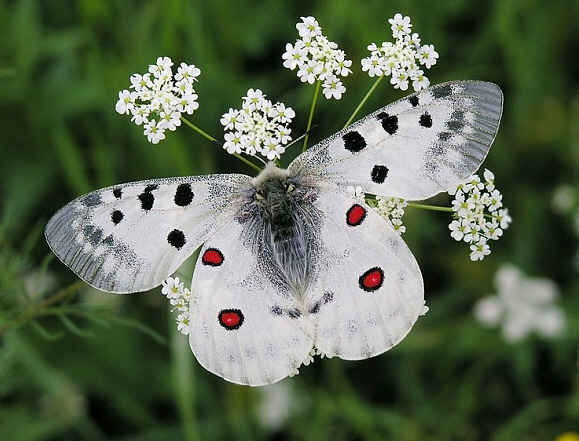 Parnassius apollo alpherakyi, Monts Katunskij, Altai – O. Kosterin
Parnassius apollo alpherakyi, Monts Katunskij, Altai – O. Kosterin
Introduction
The genus Parnassius, known commonly as Apollos, comprises of 54 species. Three of these are endemic to North America, a further 2 are found both in North America and the Palaearctic, and the remainder are distributed variously across Europe and temperate Asia.
Parnassius are instantly recognisable as a genus, having rounded translucent whitish wings that in most species are adorned with prominent white-centred red ocelli. Unlike most other Papilionidae they have short antennae with non-recurved tips.
Many Parnassius species are exceedingly rare and have a very localised distribution, but P. apollo is very widespread, being found Spain to Siberia.
Habitats
This species breeds on rocky mountainsides and limestone pavements, typically choosing sites where there are flat boulders on which they can bask, and crevices or hollows in which they can hide during bad weather. The butterflies are generally found at altitudes between about 600-2800m, although they occur at lower altitudes in Provence and in Spain.
Lifecycle
The larval foodplants include Sedum, Sempervivum and Hylotelephium.
Adult behaviour
Males sometimes imbibe mineralised moisture from damp ground, but in common with the females are more often seen in flight, or when nectaring at flowers, of which favourites include Sedum, and various thistles and knapweeds.
The butterflies have a rapid flight, soaring effortlessly across mountainsides. Their robust and stiff wings make a distinct flapping noise as they fly past. In warm sunny conditions they fly actively from flower to flower, but will sometimes remain on a single flower-head for several minutes at a time. In cooler weather they often bask on lichen-encrusted rocks and boulders, on which they can maintain a very strong grip, even in very windy conditions.
Copulation takes place at about midday, and lasts for about 2 hours, or longer if weather conditions are cooler. During copulation the females develop a large chitinous structure called a sphragis on their abdomens, which seals the genital opening and prevents other males from mating with them.
